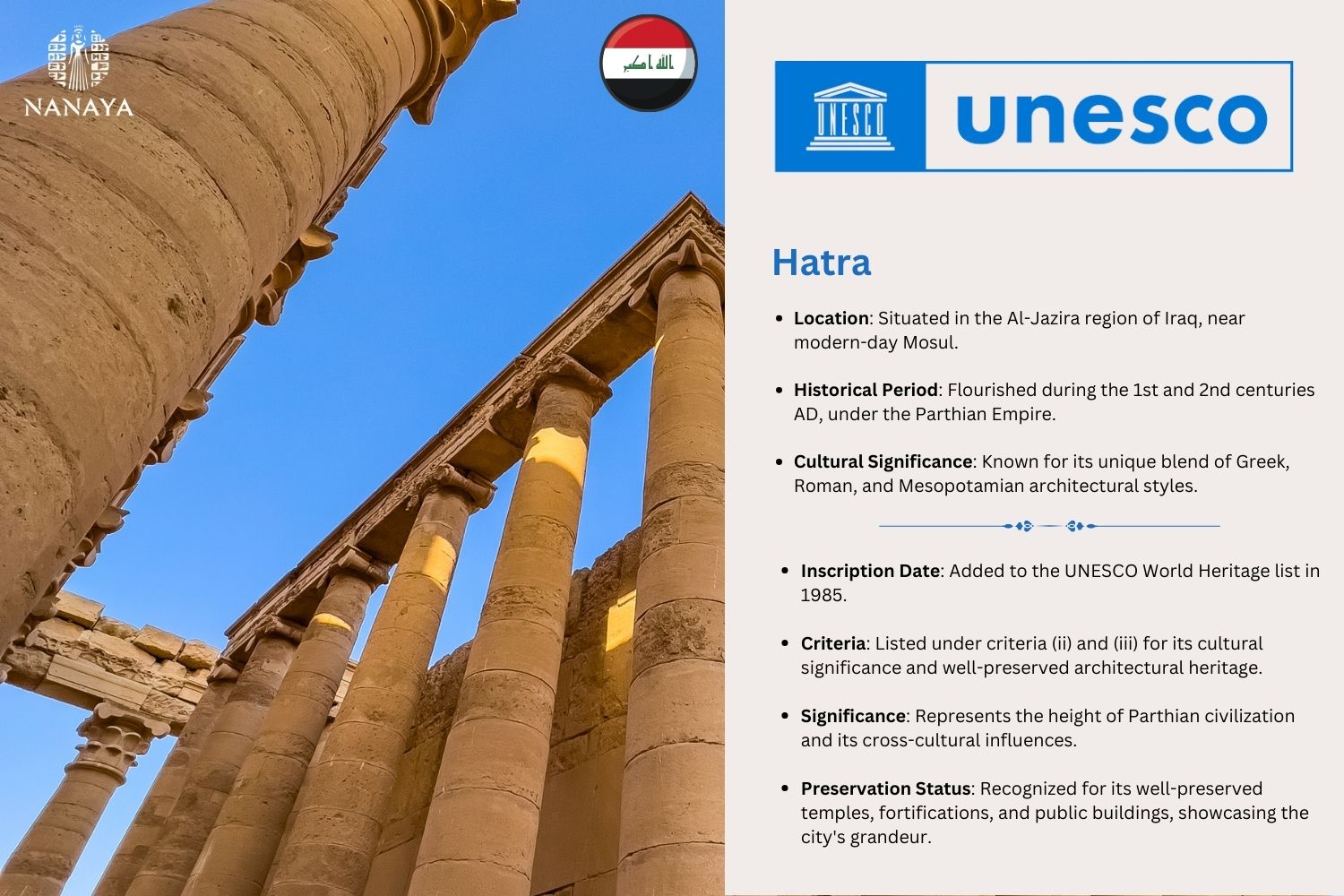
Hatra the Ancient City
Hatra the Ancient City, located in the Al-Jazira region of present-day Iraq, stands as a monumental testament to the architectural and cultural achievements of the ancient Arab world. Known for its impressive walls, gates, and temples, Hatra offers a captivating glimpse into the past. As a UNESCO World Heritage site, this ancient city is a must-visit destination for those interested in history, archaeology, and ancient civilizations.

Historical Overview
Hatra was founded in the 3rd century BC, during the Seleucid Empire, and later flourished under the Parthian Empire from the 1st century BC to the 2nd century AD. Its strategic location along key trade routes contributed to its growth and prosperity. Hatra served as a major religious and trading center, known for its impressive fortifications and grand temples.
The city was a melting pot of cultures and religions, reflecting influences from Greek, Roman, Persian, and Mesopotamian civilizations. This diverse heritage is evident in the city’s unique architectural style and the various deities worshipped by its inhabitants. Hatra’s wealth and strategic importance made it a target for conquest, but its formidable defenses allowed it to withstand several invasions, including attempts by the Roman Empire.

The Walls and Gates of Hatra
One of Hatra’s most striking features is its massive defensive walls and gates. These fortifications were designed to protect the city from invaders and showcase its strength and architectural ingenuity.
Architectural Significance
The walls of Hatra are a marvel of ancient engineering, constructed from large limestone blocks and reinforced with mudbrick. The fortifications encompass an area of approximately 320 hectares and are punctuated by numerous towers and gates.
- Outer Wall: The outer wall, stretching over 6 kilometers, encircles the entire city and features more than 160 towers. These towers provided vantage points for defenders to repel attackers and monitor the surrounding area.
- Inner Wall: A secondary inner wall added an additional layer of defense, further securing the city’s core and its important structures.
Gates
Hatra’s gates were not only functional entry points but also monumental structures that conveyed the city’s grandeur and architectural prowess. The gates were strategically placed to control access and enhance the city’s defensive capabilities.
- Main Gate: The primary entrance to the city, the Main Gate, is adorned with intricate carvings and reliefs depicting various deities and mythological scenes. This gate served as a ceremonial entrance and was the focal point of the city’s fortifications.
- Secondary Gates: Other gates, such as the Northern Gate and the Southern Gate, also feature impressive architectural details and played crucial roles in the city’s defense.
Visitor Experience
Visitors to Hatra can walk along the ancient walls and explore the gates, gaining a sense of the city’s formidable defenses and architectural grandeur. The well-preserved fortifications provide a vivid impression of Hatra’s historical significance and the engineering skills of its builders.
The Temples of Hatra
Hatra is renowned for its grand temples, which reflect the city’s religious diversity and cultural influences. The temples were dedicated to a pantheon of gods, blending elements from different traditions and showcasing the city’s cosmopolitan nature.
Temple of Shamash
The Temple of Shamash, dedicated to the Mesopotamian sun god, is one of Hatra’s most important religious structures. This temple features a large courtyard, an altar, and a series of chambers adorned with carvings and inscriptions.
- Architectural Features: The temple’s design incorporates classical elements such as columns and pediments, reflecting Hatra’s synthesis of different architectural styles.
- Religious Significance: As a major center of worship, the Temple of Shamash attracted pilgrims and devotees from across the region, highlighting Hatra’s role as a religious hub.

Temple of Allat
Another significant temple is the Temple of Allat, dedicated to the pre-Islamic goddess of fertility and war. This temple exemplifies Hatra’s cultural diversity, with influences from Greco-Roman and Mesopotamian traditions.
- Iconography: The temple is adorned with statues and reliefs depicting Allat and other deities, emphasizing the syncretic nature of Hatra’s religious practices.
- Cultural Importance: The Temple of Allat served as a focal point for religious ceremonies and community gatherings, reinforcing the city’s social and cultural cohesion.

Visitor Experience
Exploring the temples of Hatra offers visitors a chance to connect with the spiritual and cultural heritage of the ancient city. The well-preserved ruins provide insights into the religious practices and architectural innovations of the time. Guided tours can enhance the experience by offering detailed explanations of the site’s historical and cultural context.
Cultural and Modern Aspects
While Hatra’s ancient ruins are the main attraction, the surrounding region offers additional cultural and modern experiences. Visitors can engage with the local culture, enjoy traditional cuisine, and explore nearby towns and archaeological sites.
Modern Attractions Nearby
- Mosul: Located to the north of Hatra, Mosul is a vibrant city with a rich history and cultural heritage. Visitors can explore its historic sites, museums, and markets.
- Nimrud: Another significant archaeological site, Nimrud, is located nearby and features impressive Assyrian ruins and artifacts.
Cultural Experiences
- Traditional Crafts: Visitors can discover local crafts and artisanal products in the nearby towns, including pottery, textiles, and jewelry.
- Culinary Delights: Sampling traditional Iraqi dishes, such as kebabs, dolma, and masgouf, offers a taste of the region’s rich culinary heritage.
Conclusion
Hatra, with its impressive walls, gates, and temples, stands as a testament to the architectural and cultural achievements of the ancient Arab world. As a UNESCO World Heritage site, it offers a unique opportunity to explore the history and heritage of one of Mesopotamia’s most significant cities. Whether you are walking along the ancient fortifications, marveling at the grand temples, or experiencing the local culture, a visit to Hatra promises an unforgettable journey through time.

